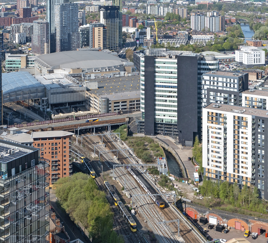Two years after the first lockdown, the economy has recovered to pre-pandemic levels. Yet we are still travelling less than we did before COVID.
A new study finds that the link between economic growth and increasing travel by private car has finally been broken. We are travelling less, but still achieving our economic and lifestyle goals. Less is more. That is new… and it ties in with the urgent need to decarbonise.
That has substantial and long-term implications for the way we provide public transport. Is subsidising reduced rail commuting bringing any real ‘levelling up’ or socio-economic benefit, as it used to be called? Do taxpayers really need to support faster journey times, more frequent services, or additional seats for people travelling on business?
Facing a sceptical Treasury, the rail industry needs to come up with convincing answers.
“It is not exaggeration to say that the coming months are critical for the long-term future of public transport,” concludes the Less is More study by respected academics at the Universities of Leeds and Stirling.
“We have been able to adapt significant elements of our daily travel to do what we want by travelling less,” they say.
“Governments have channelled huge amounts of subsidy into public transport during the pandemic. But the message is now coming through loud and clear that the purse strings are being tightened, and it is ‘last orders’ for additional revenue support.
“To meet our climate obligations, it is clear that we will need to travel less by car. As we come out of the pandemic, there is a chance to plan differently for transport, to encourage fewer trips.”
Jillian Anable, Professor of Transport and Energy at the University of Leeds, states: “Car use is not ubiquitous. One in four households does not have a car. But those households which do have a car use it for the majority of journeys. Whereas below 10% of the population use rail on any kind of regular basis. So, train users are a very select part of the population.
“Train use was disproportionately affected by COVID because of the proportion of passengers whose jobs are conducive to working from home. It’s no great surprise just how much more the railway was impacted.
“Most travel is not work-related. With car use, more than 50% of mileage is for leisure. Leisure travel bounced back, way before work travel. Leisure travel is an important part of the economy. But it is also an important part of wellbeing.
“We are in such a critical period for transport policy. As yet, there is no focus on this.”
Using new research across ten UK locations, the Less is More authors find that even if those people who worked from home go back to travelling for half their working week, car commuting will still reduce by 16%. Weekday car traffic has stabilised at around 10% below pre-pandemic levels.
The study authors call on government to commit to new incentives to lock in this lower travel, ensuring that large elements of commuting are replaced by digital connectivity as ‘business as usual’.
“If we could switch away from where the only view of development is ‘more growth means more traffic’ to one where we do not have to travel so far or so often, but can still do the things we want to, then we may have learned some of the transport resilience lessons from the pandemic,” they say.
How would that be manifested? The study does not mention major projects individually.
But: “We should ask ourselves whether the fetish for long-term investments which deliver comparatively small journey time benefits for commuters and business travellers needs re-evaluating. We have demonstrated that parts of the economy can work quite differently without relying on this.
“The pandemic has changed labour markets in ways and at a scale and pace which dwarfs transport infrastructure plans.”
Professor Anable: “COVID has turbocharged this change, accelerating the degree to which the economy and travelling have decoupled. Some of this is related to digital accessing of goods and services. We know that people were spending more on groceries during the pandemic, because they were at home more.
“Less travel happened. But expenditure did not fall. The headline story is that travel has reduced… and the economy has not.”
Professor Iain Docherty, Dean of the Institute of Advanced Studies at the University of Stirling, contends: “Rail is the most exposed travel sector. It is very dependent on occupation type. We know that rail users are wealthier, more middle class, more white collar than other transport users, and by quite some margin more than bus passengers. Buses did better during the pandemic because their passengers had to keep travelling to their fixed places of work - be that a hospital, a supermarket or factory.
“If you work in a white collar office job, you are not travelling as much to that office now. It means rail finances are very difficult.”
Anthony Smith, chief executive of Transport Focus, says it’s “quite hard” to argue with the central thesis.
“Car parks are not as full as they were - especially at stations. But rail has a big part to play in levelling up. Because rail carries a particular demographic now does not mean that’s the way it should be in the future. It is not a point to give up.
“Rail still does two things well. It carries large numbers of people relatively short distances commuting. And it carries smaller numbers of people very fast on longer distances.














